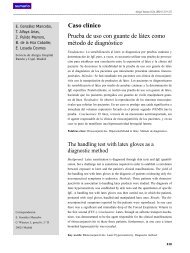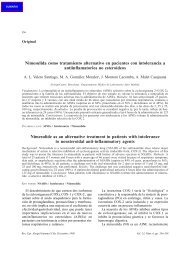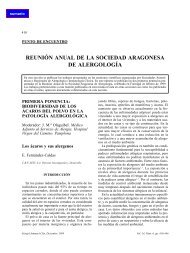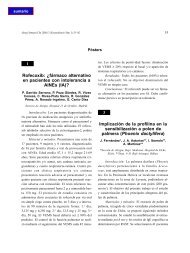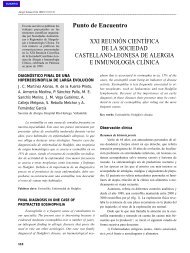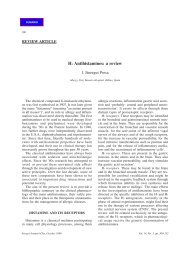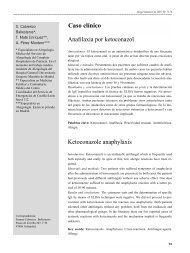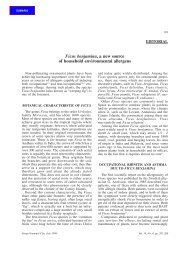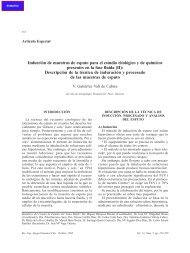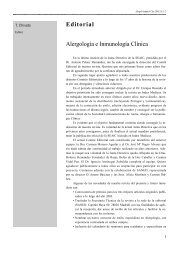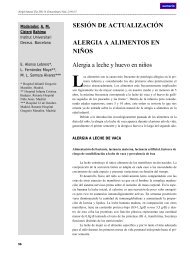Aplicación de la biología molecular en alergia a alimentos
Aplicación de la biología molecular en alergia a alimentos
Aplicación de la biología molecular en alergia a alimentos
Create successful ePaper yourself
Turn your PDF publications into a flip-book with our unique Google optimized e-Paper software.
and int<strong>en</strong>sity of IgE antibody binding, five major IgE binding<br />
regions were i<strong>de</strong>ntified in shrimp tropomyosin (P<strong>en</strong> a 1) 17 .<br />
Further efforts were directed at i<strong>de</strong>ntification of the IgE binding<br />
epitopes (<strong>de</strong>fined as the smallest sequ<strong>en</strong>ce of amino acids<br />
that yields maximal IgE binding) within each region. The<br />
same system of over<strong>la</strong>pping synthetic pepti<strong>de</strong>s was employed<br />
using shorter pepti<strong>de</strong> l<strong>en</strong>gths with varying sizes to i<strong>de</strong>ntify the<br />
minimal pepti<strong>de</strong> that binds IgE. All pepti<strong>de</strong>s were synthesized<br />
and tested as <strong>de</strong>scribed previously.<br />
Using sera from 3 to 8 shrimp-allergic individuals who<br />
recognized a particu<strong>la</strong>r region, 8 IgE-binding epitopes were<br />
i<strong>de</strong>ntified within the 5 IgE-binding regions of P<strong>en</strong> a 1: epitope<br />
1 in region 1, epitope 2 in region 2, epitopes 3a and 3b in<br />
region 3, epitope 4 in region 4 and epitopes 5a, 5b and 5c in<br />
region 5 18 . In some cases the same epitope was recognized<br />
with maximal int<strong>en</strong>sity by all subjects showing IgE reactivity<br />
to a certain region. In other cases, a common sequ<strong>en</strong>ce was<br />
i<strong>de</strong>ntified (common core), recognized by all subjects tested to<br />
that particu<strong>la</strong>r region but the l<strong>en</strong>gth of the whole epitope<br />
recognized pres<strong>en</strong>ted personal variability. IgE binding sites<br />
varied from 8 to 15 amino acid long pepti<strong>de</strong>s, <strong>de</strong>p<strong>en</strong>ding on<br />
the region and the subject studied.<br />
MOLECULAR BASIS AND CLINICAL<br />
SIGNIFICANCE OF CROSS-REACTIVITIES<br />
OF FOOD ALLERGENS OF ANIMAL ORIGIN<br />
Cross-reactivities are found among foods of re<strong>la</strong>ted phylog<strong>en</strong>etic<br />
origin and betwe<strong>en</strong> foods and seemingly unre<strong>la</strong>ted<br />
nonfood allerg<strong>en</strong>s. Milk, eggs, crustacea and fishes are examples<br />
of phylog<strong>en</strong>etically re<strong>la</strong>ted cross-reacting allerg<strong>en</strong>s existing<br />
in certain food families. Nonfood allerg<strong>en</strong>s that crossreact<br />
with foods <strong>de</strong>rived from animals are insects and dust<br />
mites 19 . The origin of food allerg<strong>en</strong> cross-reactivity is still not<br />
clear. The clinical relevance of food allerg<strong>en</strong> cross-reactivity<br />
<strong>de</strong>p<strong>en</strong>ds on the food in question. For example, cross-reactivities<br />
among crustacea are thought to be clinically relevant, since<br />
shrimp allergic subjects can react with crawfish, lobster and<br />
crab; however, although the reactivity to differ<strong>en</strong>t fishes by<br />
RAST and skin test suggests cross-reactivity, the majority of<br />
fish-allergic subjects can eat other fish species or do not react<br />
during food chall<strong>en</strong>ge 20,21 , indicating that the in vitro crossreactivity<br />
may be of limited clinical relevance.<br />
The substantial cross-reactivity among Crustacea appears<br />
to be clinically important 22 ; shrimp-allergic subjects can<br />
react to other crustaceans without additional s<strong>en</strong>sitization. The<br />
cause of this cross-reactivity is probably due to the major<br />
Applications of Molecu<strong>la</strong>r Biology in Food Allergy Allerg<strong>en</strong>s of Animal Origin<br />
allerg<strong>en</strong> tropomyosin, a highly conserved muscle protein.<br />
Allerg<strong>en</strong>ic tropomyosin (P<strong>en</strong> a 1, P<strong>en</strong> i 1, and Met e 1) has<br />
be<strong>en</strong> i<strong>de</strong>ntified in three shrimp species: brown shrimp (P<strong>en</strong>aeus<br />
aztecus) 6 , Indian shrimp (P. indicus) 14 , and greasyback<br />
shrimp (Metap<strong>en</strong>aeus <strong>en</strong>sis) 15 . P<strong>en</strong> a 1-like proteins were<br />
<strong>de</strong>tected in crab, crawfish, and lobster using sera of shrimpallergic<br />
subjects and P<strong>en</strong> a 1-specific monoclonal antibodies 23 .<br />
The amino acid sequ<strong>en</strong>ce simi<strong>la</strong>rity among these differ<strong>en</strong>t<br />
shrimp tropomysosins is very high; for example, the amino<br />
acid sequ<strong>en</strong>ces of Met e 1 and P<strong>en</strong> a 1 only differ in one position.<br />
Inspite of the substantial cross reactivity among p<strong>la</strong>nt<strong>de</strong>rived<br />
allerg<strong>en</strong>s or among animal <strong>de</strong>rived allerg<strong>en</strong>s as <strong>de</strong>scribed<br />
above, there is little if any reports of cross reactivity betwe<strong>en</strong><br />
p<strong>la</strong>nt <strong>de</strong>rived and animal <strong>de</strong>rived allerg<strong>en</strong>s. Certainly from a<br />
phylog<strong>en</strong>etic and structural viewpoint, this makes s<strong>en</strong>se.<br />
Assessm<strong>en</strong>t of IgE antibody reactivity to foods and its<br />
re<strong>la</strong>tionship to specific food-allergic responses may be complicated<br />
by cross-reactivity that can occur among certain food<br />
families and betwe<strong>en</strong> foods and seemingly unre<strong>la</strong>ted allerg<strong>en</strong>s.<br />
Based on the fact that tropomyosin allerg<strong>en</strong>s have be<strong>en</strong> i<strong>de</strong>ntified<br />
in invertebrates such as cockroaches, dust mites, and<br />
shrimp, IgE antibody reactivity to the major shrimp allerg<strong>en</strong><br />
P<strong>en</strong> a 1 was assessed in an unexposed popu<strong>la</strong>tion of Orthodox<br />
Jews who observe Kosher dietary <strong>la</strong>ws that prohibit eating<br />
shellfish 24 . Sera from 9 subjects reporting to an allergy clinic<br />
located in a strictly orthodox town (Bnay Braq, Israel), who<br />
<strong>de</strong>monstrated positive skin tests to shrimp extract, were selected<br />
for study. Subjects were strictly observant with no prior<br />
exposure to seafood (regar<strong>de</strong>d as non-Kosher). Six/9 reported<br />
symptoms of asthma, atopic <strong>de</strong>rmatitis, rhinitis and/or sinusitis.<br />
All had positive skin prick tests to shrimp (P<strong>en</strong>aeus setiferous),<br />
and dust mite (Dematophagoi<strong>de</strong>s farinae, Dematophagoi<strong>de</strong>s<br />
pteronissynus or both); 2/7 subjects tested for<br />
cockroach (mix of B<strong>la</strong>ttel<strong>la</strong> germanica and Perip<strong>la</strong>neta americana)<br />
were found positive.<br />
All sera were tested for IgE antibody reactivity to<br />
shrimp and the major shrimp allerg<strong>en</strong> P<strong>en</strong> a 1 by radioallergosorb<strong>en</strong>t<br />
test (RAST) and immunoblot assay (IB). Crossreactivity<br />
of mite and/or cockroach with shrimp allerg<strong>en</strong>s was<br />
assessed by RAST and immunoblot inhibition assays. Three/9<br />
subjects <strong>de</strong>monstrated positive IgE antibody responses to both<br />
shrimp (RAST 7.0 to 15.2%), and to P<strong>en</strong> a 1 (6.3% to 24.1%).<br />
Significant IgE reactivity to P<strong>en</strong> a 1 and to mite extract was<br />
<strong>de</strong>monstrated in the 3 sera by IB. IgE binding to P<strong>en</strong> a 1 was<br />
inhibited with either mite or cockroach extracts as <strong>de</strong>monstrated<br />
by both RAST (Table II) and IB inhibition analysis. These<br />
studies indicate that IgE antibody reactivity to a major food<br />
23




